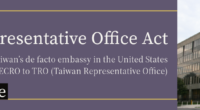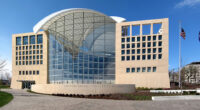Japan Could “Recognize Taiwan as a Country” One Day
Japan is likely to recognize Taiwan as a country should Taiwan continue to be governed freely and democratically, former Japanese vice minister of defense Yasuhide Nakayama said in Taipei on December 8.
“Taiwan has all the basic elements of a nation — territory, people and a clearly defined population. I believe that it is highly possible that Taiwan will be recognized by Japan as a country if it maintains a free and democratic system,” Nakayama said at a news conference during his first visit to Taiwan.
Japan reportedly is planning to expand its military units on Okinawa in anticipation of possible conflicts with China over Taiwan.
Nakayama said the Japanese government has been concerned about China’s ambitions in the South China Sea and the Ryukyu Islands, and that Japan has been increasing its defense budget since the Abe administration, including reinforcing the Ryukyu Islands’ military infrastructure.
It is important that the U.S., Japan and other democratic allies protect Taiwan and make sure that it is not orphaned by the international community, he said.
In his opening remarks at the news conference, Nakayama cited China and Russia as the two biggest military threats facing Japan.
When China held live-fire drills in August following the visit to Taiwan by U.S. House Speaker Nancy Pelosi, five ballistic missiles were reportedly fired into waters that are part of Japan’s exclusive economic zone.
“It was not a coincidence. The Chinese People’s Liberation Army did it on purpose to threaten Japan. This is evidence of why ‘a Taiwanese emergency is Japanese emergency,’” Nakayama said.
“Unlike World War II, nearly 80 years ago, when war was mainly fought on land, at sea and in the air, the battlefields have now expanded to space, cyberspace and electromagnetic technology” that targets radar and communications systems, he said.
Taiwan needs to strengthen its resilience in these new battlefields, and increase partnerships with the U.S. and Japan against possible Chinese attacks, he added.
Reference:
[1] Taipei Times: https://www.taipeitimes.com/News/front/archives/2022/12/09/2003790399
Taiwan’s Domestic Cruise Missile Could Reach Beijing: Ex-military Research Chief
The former head of Taiwan military’s top research unit has disclosed in a recently published memoir that Taiwan’s domestically developed supersonic land-attack cruise missile has a range of 1,000 kilometers, meaning it could reach as far as China’s capital Beijing.
Retired Rear Admiral Kung Chia-cheng, a former president of the state-run weapons developer National Chung-Shan Institute of Science & Technology (NCSIST), made the claim in a memoir published in November.
The domestic cruise missile was developed under the “Yun Feng” (Cloud Peak) project codenamed W-99, according to Kung in his memoir.
The Yun Feng missile can exceed Mach 3 and has excellent penetration capability, as it can reach targets vertically. The missile’s speed ensures that it is not easily intercepted, Kung added.
Kung is reportedly the first NCSIST member directly involved in the development of the domestic supersonic cruise missile system to publicly confirm it has a range as great as 1,000km.
Taiwan’s Legislative Speaker You Si-kun made a similar claim about the range of the domestic cruise missiles during his online keynote speech for the Taiwanus.net forum in June this year.
“Taiwan will not invade China, but China should take Taiwan’s ability to attack Beijing into consideration before launching an invasion [of Taiwan],” You said.
He also disclosed that such missiles have officially entered mass production.
On December 14, Taiwan’s Ministry of National Defense refused to comment on Kung’s remarks.
The NCSIST, which is Taiwan’s main research and development hub for domestically produced weapons, also said it had no comment on the “personal view” of an individual.
Kung served as NCSIST chief from December 2003 to December 2007. During that period, the institution developed some of the nation’s top long-range missiles, including the Hsiung Feng II (HF-2) and Hsiung Feng III (HF-3) anti-ship missiles.



